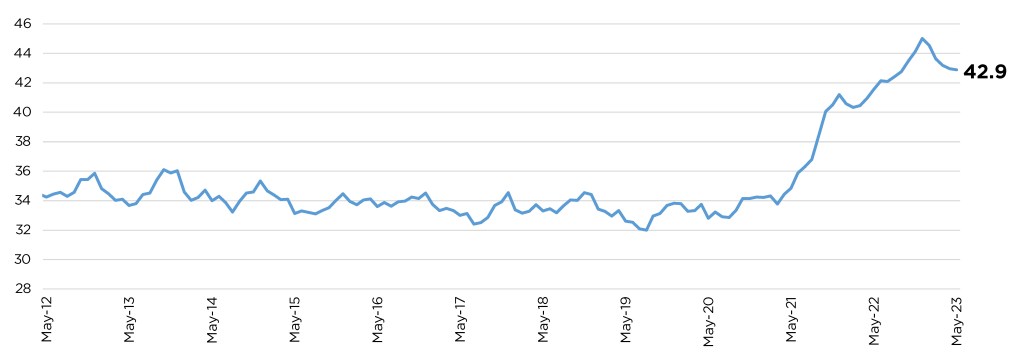Data Point
Strong Income Growth Helps New-Vehicle Affordability Improve Slightly in May
Thursday June 15, 2023
New-vehicle affordability improved slightly again in May. Strong income growth helped to offset modestly higher prices and slightly higher rates. Higher prices and rates caused the typical payment to increase slightly from what had been the lowest payment in April since October. The number of median weeks of income needed to purchase the average new vehicle in May declined to 42.9 weeks from an upwardly revised 43.0 weeks in April.
Cox Automotive/Moody’s Analytics Vehicle Affordability Index
May 2023
Weeks of Income Needed to Purchase a New Light Vehicle

Estimated Typical New Car Monthly Payment Increased to $768
The median income grew 0.3%, and incentives from manufacturers increased, and both of those moves helped consumers with affordability. The average new vehicle transaction price increased by 0.5% in May, according to Kelley Blue Book. The typical new-vehicle loan interest rate increased 3 basis points to 9.57%1. As a result of these mixed changes, the estimated typical monthly payment increased by 0.1% to $768, from an upwardly revised $767 in April. The average monthly payment peaked at $792 in December.
“The Fed pausing rate hikes after 15 months doesn’t undo the numerous increases that have limited new-vehicle retail sales growth over the past year,” said Cox Automotive Chief Economist Jonathan Smoke. “However, the good news for consumers is that the rates they see on auto loans likely peaked earlier this year and may not move up despite the threat of another rate increase in July.” [For more on the Fed’s recent pause, read Smoke on Cars.]
New-vehicle affordability in May was still worse than a year ago when prices and interest rates were lower. The estimated number of weeks of median income need to purchase the average new vehicle in May was up 3.1% from last year.
Click here for the full methodology for the Cox Automotive/Moody’s Analytics Vehicle Affordability Index.
The next update of the Cox Automotive/Moody’s Analytics Vehicle Affordability Index will be published on July 14, 2023.
1 The index input of the average interest rate paid by consumers is calculated to reflect a 72-month, fixed-rate loan. For the Dealertrack estimated, volume-weighted average new loan rate in April, visit the Auto Market Snapshot.
The Cox Automotive/Moody’s Analytics Vehicle Affordability Index (VAI) is updated monthly using the latest data from government and industry sources, including key pricing data from Kelley Blue Book, a Cox Automotive company. This important industry measure will be released at mid-month to indicate if the prices paid for new vehicles are moving out of consumers’ financial reach or becoming more affordable over time.
